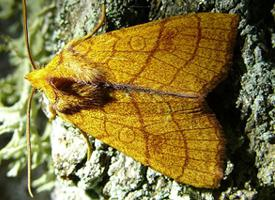
Description de l'animal
The Snout, scientifically known as Hypena proboscidalis, is a fascinating moth species belonging to the family Erebidae. This intriguing insect is primarily found across Europe and in parts of Asia, extending its habitat through a variety of environments, from gardens and hedgerows to woodlands and grassy fields. What sets the Snout apart from other moth species is its distinctive physical appearance and behavior, making it a subject of interest among entomologists and nature enthusiasts alike.One of the most remarkable features of the Snout moth is its elongated labial palps, which extend forward from its head, resembling a long snout. This unique adaptation not only contributes to its common name but also serves a functional role in the moth's feeding habits. The Snout's coloration is another aspect of its appearance that aids in its survival; its wings display a range of brown, gray, and sometimes subtle green hues, patterned in a way that provides excellent camouflage against tree bark and leaves, offering protection from predators.
The wingspan of the Snout moth is typically between 28 to 35 millimeters, making it a medium-sized moth. Its forewings are characterized by a somewhat scalloped edge and a complex pattern of lines and spots that can vary significantly between individuals, contributing to its effective camouflage. The hindwings are usually lighter in color and less conspicuously patterned.
In terms of behavior, the Snout moth is nocturnal, like many of its relatives. It is attracted to light sources, which is a common trait among moth species, making it a frequent visitor to lit windows and outdoor lights during the night. The adult moths are most active from late spring through autumn, depending on the climate of their habitat.
The lifecycle of the Snout moth involves several stages, starting from eggs laid on the underside of host plant leaves. Upon hatching, the larvae feed on the leaves of a wide variety of plants, including nettles (Urtica dioica), demonstrating a generalist feeding behavior. This dietary flexibility is one of the factors contributing to the Snout moth's widespread distribution. After completing their development, the larvae pupate, emerging as adult moths to continue the cycle.
The Snout moth plays a role in the ecosystem as both a pollinator and a source of food for other species. While its pollination activities are not as significant as those of some other insect species, it contributes to the pollination of nocturnally blooming plants. Predators of the Snout moth include bats, birds, and various arthropods, making it an integral part of the food web in its natural habitat.
In conclusion, the Snout (Hypena proboscidalis) is a remarkable moth with distinctive features and behaviors that make it a unique and fascinating creature. Its adaptability, camouflage capabilities, and role in the ecosystem highlight the complexity and interconnectivity of the natural world, underscoring the importance of conserving biodiversity and understanding the lives of even the smallest creatures.
Animaux similaires
Nouvelles photos d'animaux
Top 10 des animaux
- Dolphin gull (Leucophaeus scoresbii)
- Japanese macaque (Macaca fuscata)
- Stone loach (Barbatula barbatula)
- Greek tortoise (Testudo graeca)
- Russian tortoise (Testudo horsfieldii)
- Galápagos tortoise (Geochelone nigra complex)
- Diana monkey (Cercopithecus diana)
- Moustached guenon (Cercopithecus cephus)
- Common flying dragon (Draco volans)
- Galápagos penguin (Spheniscus mendiculus)
